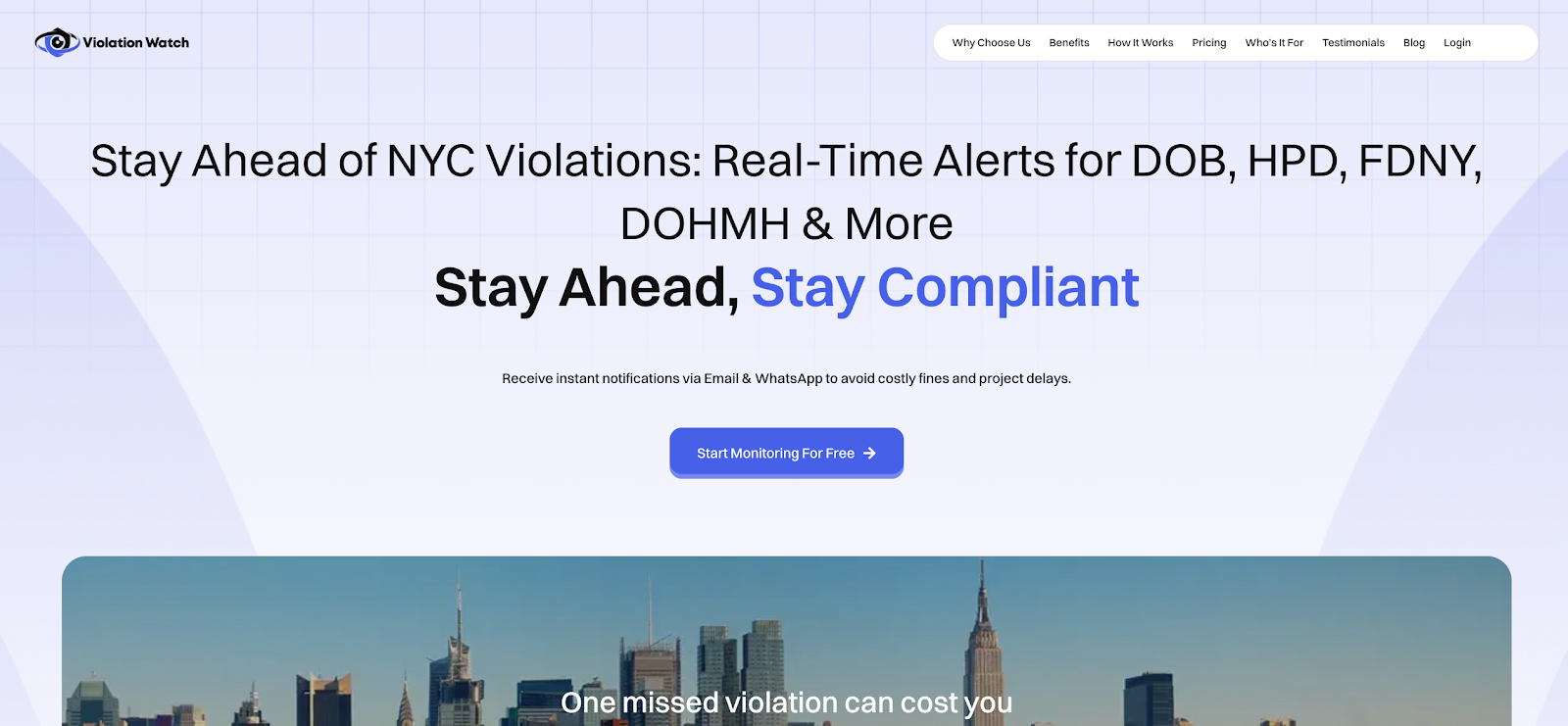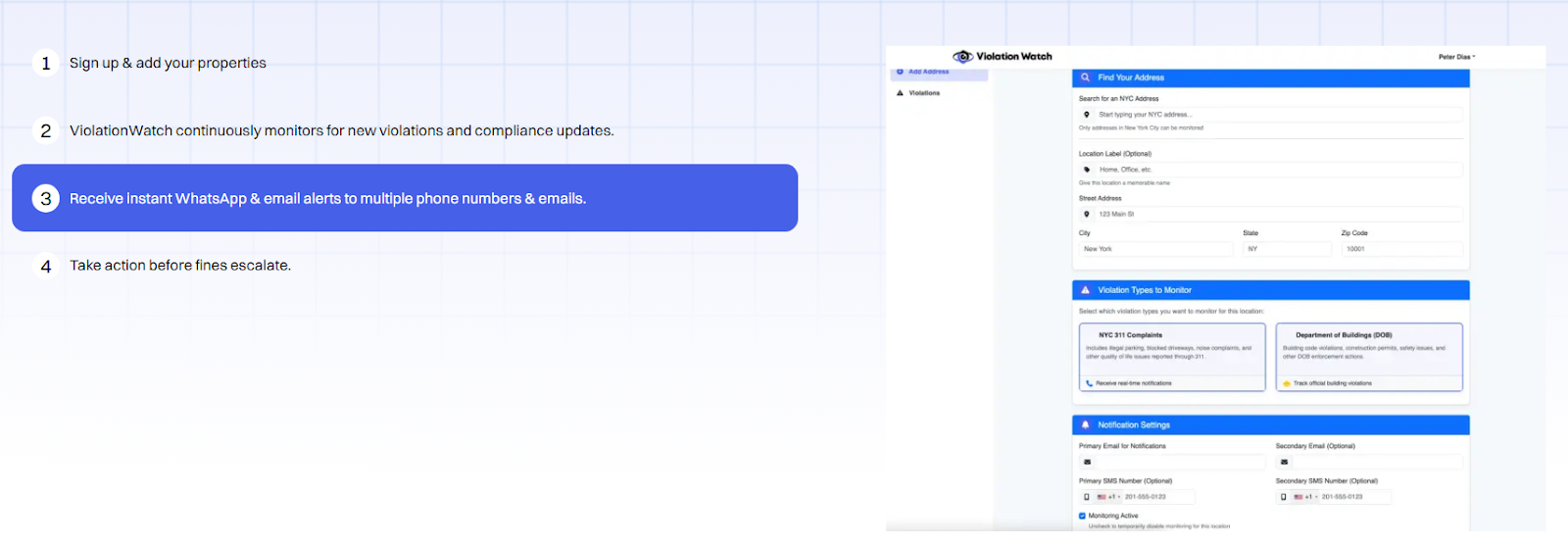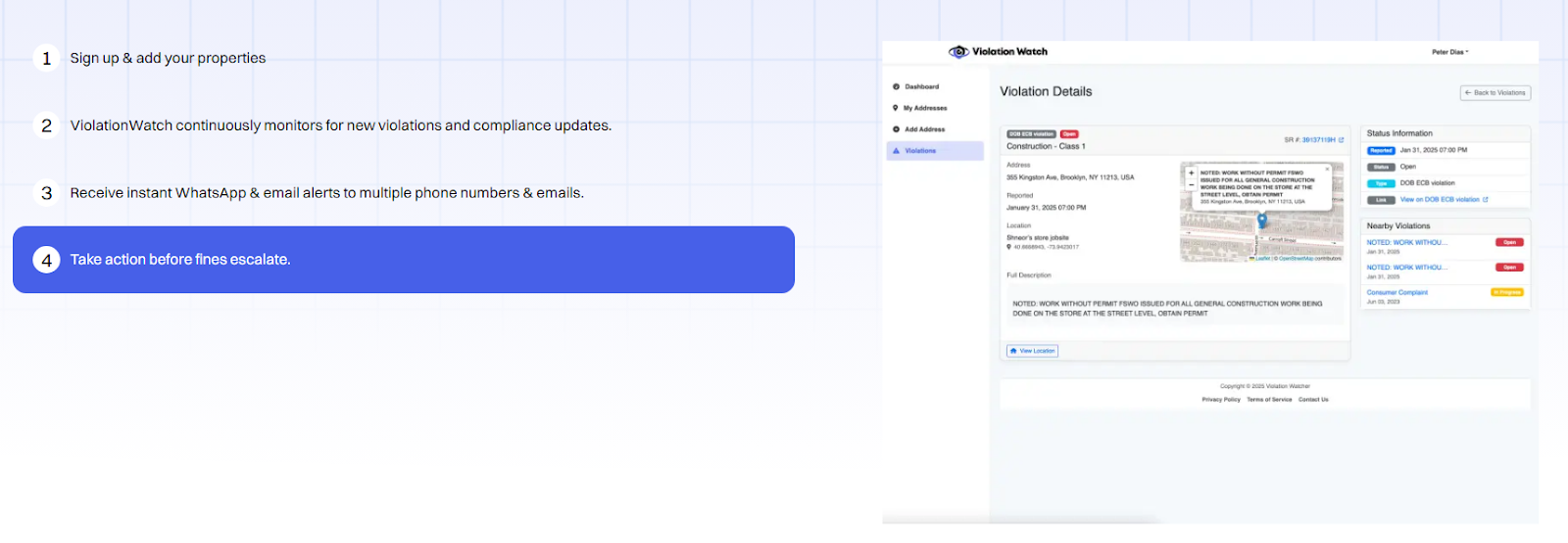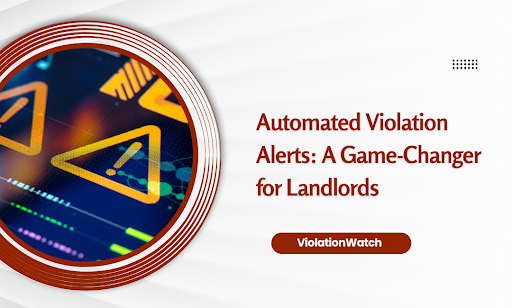Imagine you’re enjoying dinner when your phone buzzes. Another NYC violation just hit one of your buildings. But this time, you knew about it instantly, not three weeks later when the fine doubled.
That’s the difference automated alerts make. Most NYC property owners still check violation sites manually. They log into DOB, then HPD, then ECB. Every. Single. Day. Some never check at all until a tenant complains or a massive fine arrives.
Here’s the brutal truth: NYC issues over 200,000 violations annually. Miss just one deadline and you’re looking at fines from $250 to $25,000. Add legal fees, court appearances, and potential tenant lawsuits — the costs pile up fast. But what if violations never caught you off guard again?
In this article, we’ll show you exactly how automated violation alerts transform property management:
- Why manual violation tracking fails (and costs you thousands)
- The critical moments when instant alerts save your bottom line
- How real-time notifications prevent 90% of escalated violations
- The automated alert system that NYC’s smartest landlords already use
No more logging into multiple city websites. No more surprise fines. Just instant knowledge and the power to act before problems spiral.
Let’s dig into why automated alerts aren’t just convenient — they’re essential for profitable property management in NYC.
The Hidden Tax of Manual Violation Tracking
You check the DOB’s website on Monday. HPD on Tuesday. ECB, when you remember. By Friday, you’ve already missed two new violations that were posted Wednesday afternoon. This broken system costs NYC landlords millions annually.
The math is simple. Each city agency operates its own violation portal. DOB has one. HPD has another. ECB, FDNY, DEP — they all run separate systems with different interfaces, update schedules, and notification methods.
Property managers waste 5-10 hours weekly just logging into these sites. That’s 260-520 hours per year of pure administrative burden. At $75/hour for skilled property management time, you’re burning $19,500 to $39,000 annually on checking websites.
But that’s just the visible cost.
The Real Price of Missing Violations
According to NYC Department of Finance data, property owners paid over $1.2 billion in violation-related fines last year. The average fine? $1,847. Most telling, 73% of these fines included late penalties that doubled or tripled the original amount.
Think about what happens when you miss a simple DOB violation:
- Day 1: $800 base fine
- Day 30: $1,600 with late penalty
- Day 60: $3,200 plus interest
- Day 90: Lien on property
One missed violation snowballs into a financial nightmare. Multiply that across a 10-building portfolio, and you’re hemorrhaging money on preventable penalties.
Why Even Organized Landlords Fail
You might have spreadsheets. Calendar reminders. A dedicated compliance person. None of it matters when violations post randomly across nine different city websites.
The manual tracking problem hits three ways:
- Timing gaps: Violations occur at any time — nights, weekends, holidays. Your Monday morning check misses Friday afternoon postings.
- Human error: People get sick, take vacations, and forget passwords. One missed login creates cascading problems.
- Information overload: Checking nine agency sites daily burns people out. They start skipping “less important” agencies. Then DEP hits you with a $5,000 water meter violation you never saw coming.
The Compliance Trap
Here’s what makes manual tracking especially painful — you can’t scale it. Own one building? Maybe you manage daily checks. Own five? You need part-time help. Own twenty? You’re hiring full-time staff just to refresh government websites all day.
Meanwhile, NYC keeps adding violation types. New Local Laws create new compliance requirements. Environmental regulations multiply. Fire safety codes expand. Each new rule means another portal to monitor, another deadline to track.
This inefficiency affects every aspect of managing rental properties — from handling tenant complaints to coordinating maintenance schedules. When your team spends all day checking violation portals, they can’t focus on more critical tasks like enhancing efficiency across your portfolio.
Something has to change.
Critical Moments When Instant Alerts Save Your Bottom Line

Timing changes everything in violation management. The difference between knowing now versus knowing next week is often measured in thousands of dollars. Here are the exact moments when immediate notification transforms your financial outcome.
The 24-Hour Cure Window
Several NYC violations offer a critical grace period — fix the issue within 24-48 hours and avoid the fine entirely. HPD heat complaints work this way. Get notified immediately, dispatch your boiler technician, restore heat within 24 hours, and document the repair. No fine. No court appearance. No tenant lawsuit.
Miss that window? You’re facing:
- Base fines starting at $250-$500 per day
- Mandatory court appearances
- Potential tenant-initiated HP actions
- Legal fees averaging $2,000-$5,000
The same cure windows exist for:
- Emergency elevator violations
- Certain fire safety infractions
- Water pressure complaints
- Specific electrical hazards
Without instant alerts, you burn through cure periods before even knowing violations exist.
Pre-Lien Intervention Points
NYC follows a predictable escalation pattern for unpaid violations:
- Day 1-30: Base fine amount
- Day 31-60: Late penalties applied (typically 50-100% increase)
- Day 61-90: Interest accrues daily
- Day 91+: Lien preparation begins
The sweet spot? Days 25-30. This gives you time to investigate, gather documentation, and pay or contest before late penalties hit.
But here’s the catch — you need to know about the violation early enough to use this window effectively. Manual checking often means you first see violations already 20+ days old, leaving no room for strategic response. This same timing principle applies to rent collection and payment reminders — the ability to respond quickly makes all the difference in maintaining healthy cash flow.
Hearing Preparation Deadlines
ECB violations require particularly careful timing. You typically get:
- 30-45 days to request a hearing
- 10 days to submit evidence after scheduling
- 5 days to file appeals after decisions
Miss any deadline? You forfeit your defense rights.
Instant alerts give you maximum preparation time. You can:
- Photograph the current conditions immediately
- Pull permits while the records are fresh
- Contact witnesses while memories remain clear
- Consult attorneys before options expire
Property managers who learn about ECB violations late scramble to build defenses with stale evidence. Judges notice. Fines stick.
Multi-Violation Pattern Detection
The most expensive violations aren’t isolated incidents — they’re patterns agencies use to label you a “problem property.”
Watch what happens:
- 3 similar violations = increased scrutiny
- 5 violations = targeted inspections
- 10+ violations = potential receivership discussions
Instant alerts let you spot patterns early. Two quick HPD complaints about the same boiler? Time for full replacement, not another patch job. Multiple elevator violations across your portfolio? Your maintenance contractor needs immediate replacement. Without real-time notification, patterns only become visible after agencies have already flagged your properties for enhanced enforcement.
These moments represent tens of thousands in potential savings. The technology to capture them exists. The question becomes: how long will you keep gambling with manual checks?
How Real-Time Notifications Stop Violations from Spiraling Out of Control

Escalated violations follow predictable paths. Real-time alerts interrupt these paths before small problems become expensive disasters. Let’s break down the prevention mechanics.
The Escalation Timeline
Every violation starts with a manageable. A broken exit sign. A missing permit. A late registration. These initial infractions carry modest fines, usually under $1,000. But violations rarely stay simple. Here’s the typical progression:
- Week 1-2: Original violation issued
- Week 3-4: Reinspection scheduled
- Week 5-6: Failed reinspection = doubled fines
- Week 7-8: Second failure = court summons
- Week 9-12: Legal proceedings begin
- Week 13+: Liens, receivership threats, tenant lawsuits
Real-time notifications break this chain at Week 1.
Prevention Through Immediate Action
Instant alerts enable four types of preventive responses:
1. Quick Fixes:
- Broken emergency light? Replace within 24 hours
- Missing signage? Install before reinspection
- Expired permit? Renew online immediately
These fixes cost $50-500. Waiting costs $5,000-50,000.
2. Documentation Gathering: Fresh evidence wins violation disputes. Real-time alerts let you:
- Photograph conditions immediately
- Pull work permits while accessible
- Get contractor affidavits while memories are sharp
- Record tenant statements before stories change
Judges give more weight to evidence collected within days versus weeks after violation issuance.
3. Strategic Consolidation: Multiple violations often stem from a single root cause. Instant notification reveals these connections:
- Three apartments with lead paint violations? Building-wide remediation prevents 20 more
- Two elevator complaints? Full modernization stops monthly fines
- Several heat complaints? Boiler replacement ends the violation cycle
Without immediate alerts, you treat symptoms while root problems multiply and violations.
4. Professional Intervention Timing: Certain violations demand expert response:
- Structural issues need immediate engineering assessments
- Environmental violations require certified remediation
- Fire safety infractions need licensed contractors
Real-time alerts maximize professional response windows. Engineers can inspect before conditions worsen. Lawyers can file appeals before deadlines pass. Contractors can schedule work before busy seasons.
The Compound Effect
Each prevented escalation creates cascading benefits:
Financial
- No late penalties or interest charges
- Avoid court costs and legal fees
- Prevent rent strikes and tenant lawsuits
- Maintain property values and financing options
Operational
- Reduce staff time on crisis management
- Preserve vendor relationships
- Maintain positive tenant relations
- Avoid regulatory target status
Strategic
- Keep clean compliance records
- Qualify for better insurance rates
- Attract quality tenants
- Enable portfolio expansion
Breaking the Violation Cycle
Properties fall into two categories — those catching violations early and those constantly fighting escalations. The difference? Response speed.
Early responders:
- Address issues before reinspections
- Build positive inspector relationships
- Create documentation trails
- Establish prevention protocols
Late responders:
- Fight compounded fines
- Face hostile inspections
- Scramble for evidence
- React to emergencies
Real-time notifications shift properties from the second category to the first. One building at a time. One violation at a time. Until escalations become rare exceptions rather than expensive norms.
This proactive approach to violation management demonstrates how automation and advanced tools enable better decision making, moving beyond traditional methods to create solutions that save time while increasing transparency.
The Automated Alert System NYC’s Smartest Landlords Already Use

Smart property management requires smart tools. ViolationWatch automates what manual tracking can’t — continuous, real-time monitoring across all NYC violation sources.
The Algorithm Behind 24/7 Violation Monitoring
ViolationWatch operates through a sophisticated monitoring engine that works like this:
Continuous API Integration
- Direct connections to DOB, HPD, ECB, FDNY, DEP, DEC, DOH, DOT, DSNY, and DOF databases
- Checks run every 15-30 minutes throughout the day
- Weekend and holiday monitoring never stops
- Zero manual intervention required
Intelligent AI-Powered Technology
- Links violations to your exact properties using BBL numbers
- Filters out irrelevant notices from neighboring addresses
- Groups related to violations for consolidated action
- Tracks status changes automatically
Multi-Channel Alert Distribution
- WhatsApp messages are sent directly to your phone
- Email notifications to multiple team members
- Text alerts for urgent violations
- Dashboard updates for comprehensive tracking
Getting Started Takes 4 Simple Steps
Looking at the actual interface, here’s exactly how setup works:
- Sign up & add your properties: Enter your building addresses or BBL numbers into the system.

- ViolationWatch continuously monitors for new violations: The platform immediately begins scanning all agency databases.

- Receive instant WhatsApp & email alerts: Notifications arrive at multiple phone numbers and emails simultaneously

- Take action before fines escalate: Access violation details, deadlines, and resolution paths instantly

The dashboard shows everything at a glance — open violations in red, cured violations in green, dismissed in yellow, and those under investigation in blue.
The Numbers That Matter
ViolationWatch pricing breaks down simply:
- Free Trial
- $0/month
- Full platform access
- Monitor only 1 property
- All alert features included
- Per Address Plan
- $9.99 per address monthly
- Unlimited violations tracked
- Unlimited users and alerts
- No setup fees or contracts
Compare that to violation costs. One missed HPD violation averages $1,200. One overlooked ECB summons hits $5,000+. The math speaks for itself.
Why Instant Notifications Transform Property Management
The real power of automated alerts lies in the fundamental shift they create — from constantly playing catch-up to staying ahead of problems.
Think about speed first. With manual tracking, you’re always behind. You check the DOB site Monday morning and see a violation posted Friday afternoon. That’s already three days lost. By the time you coordinate with your team, gather documentation, and plan a response, you’re a week in. With automated alerts, that same violation hits your phone Friday at 3:47 PM. You dispatch maintenance before the close of business.
Coverage presents an even bigger transformation. Manual checks create blind spots everywhere — weekends, holidays, lesser-known agencies like DEC or DSNY. You focus on the “big three” (DOB, HPD, ECB) while violations pile up elsewhere. Automated monitoring eliminates these gaps. Every agency, every violation, every status change gets tracked without you lifting a finger.
But the most dramatic change happens in team coordination.
- Before automated alerts: Property manager sees violation → emails maintenance supervisor → supervisor checks schedule → assigns technician → work gets done (maybe) → someone updates spreadsheet → manager hopes it’s resolved in time.
- With instant notifications: Violation posts → WhatsApp alerts hit property manager, supervisor, and owner simultaneously → maintenance dispatch happens within hours → resolution tracked in real-time → everyone knows exact status without asking.
The violation details screen becomes your command center. You see the exact violation type, the compliance deadline in bold red numbers, full issue descriptions, and all related documents in one place. No more hunting through emails or logging into multiple sites.
Property managers report remarkable shifts after implementing automated alerts. Late penalties drop by 90% because you never miss deadlines. Resolution times have improved by 75% since you started working immediately. Time spent on compliance tasks falls 60% — no more manual checking and tracking. Perhaps most importantly, repeat violations decrease by 40% as you identify and fix root causes rather than scrambling to address symptoms.
As modern property management software evolves, ViolationWatch exemplifies how automated systems can streamline property management across multiple properties. The platform’s automated reminders work alongside features like smart locks and tenant communication tools to create seamless communication between property managers and residents.
This comprehensive approach extends beyond violations to support critical tasks like maintaining high occupancy rates and ensuring tenant satisfaction. By leveraging data-driven insights, property managers can allocate resources more effectively and resolve violations before they impact the rental unit or trigger legal disputes.
The technology exists. The cost is minimal. The only question remaining is how many more violations you’ll let slip through before making the switch.
Stop Chasing Violations — Start Getting Automated Alerts
You now understand why manual violation tracking costs NYC landlords millions annually. The broken system of checking nine different agency websites, missing critical deadlines, and paying escalated fines doesn’t have to be your reality anymore. Smart property management starts with knowing about violations the moment they occur, not weeks later when fines have doubled.
Here’s what automated alerts deliver, based on everything we’ve covered:
- Eliminated manual checking across 9+ NYC agencies
Result: Save 5-10 hours weekly, freeing $19,500-$39,000 in annual labor costs - Instant notification within minutes of the violation posting
Result: Capture 24-48 hour cure windows that erase fines entirely - Real-time alerts prevent 90% of escalated violations
Result: Avoid late penalties that double or triple the original fines - Multi-channel notifications to entire teams
Result: 75% faster resolution times through immediate coordination - Continuous monitoring, including nights, weekends, and holidays
Result: Zero blind spots means zero surprise liens or court summons - Automated tracking of status changes and deadlines
Result: Never miss hearing dates or reinspection windows again
The key benefits extend throughout your entire operation. With the right technology, you gain valuable time to focus on what matters — building a thriving community for your tenants. For example, rather than spending hours on violation websites, you can invest in effective communication that prevents issues before they become violations.This efficient approach to compliance is crucial for modern property management. The path forward is clear. Every day you continue manual tracking is another day you risk thousands in preventable fines. The technology to transform your violation management exists right now. ViolationWatch puts automated alerts in your pocket for less than the cost of a single missed violation, turning what was once a landlord’s biggest headache into a solved problem.

